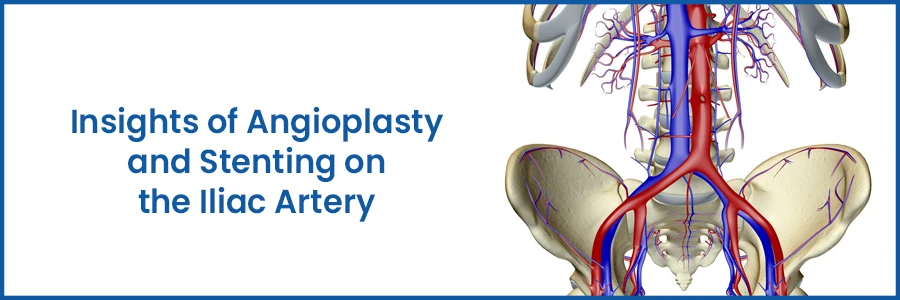Categories
- Cardiology 84
- Dermatology 45
- Endocrinology 33
- ENT 16
- Fertility 190
- Gastroenterology 78
- General-Medicine 81
- Gynecology 80
- Hematology 19
- Infectious-Diseases 33
- Neurology 52
- Oncology 34
- Ophthalmology 23
- Orthopedics 69
- Pediatrics 31
- Procedure 23
- Public-Health 144
- Pulmonology 59
- Radiology 8
- Urology 68
- Wellness 161
- Woman-and-child 77

Understanding Angioplasty & Stenting for Iliac Artery Health
A minimally invasive procedure called iliac angioplasty and stenting is needed to treat blockages of the iliac artery walls, which may be necessary to allocalledod to glide to the pelvis and leg. A stent is often required and balloon inflation to expand the channel in order to maintain patency and raise vascular fitness.
Secure your health with a second opinion. Make informed decisions and book your appointment today!
Get A Second OpinionIliac Angioplasty Procedure:
- The iliac artery supplies blood to the lower limbs and is prone to narrowing or blockage.
- Iliac angioplasty is a minimally invasive procedure using a catheter with a balloon that inflates at the blockage site.
- The balloon expands the artery, improving blood flow by clearing blockages or cholesterol buildup.
- A stent may be implanted afterwards to support the artery structurally and prevent collapse.
- This procedure reinforces the artery with a thin, mesh-like tube to maintain blood flow integrity.
Iliac Angioplasty and Stenting:
- Iliac angioplasty and stenting are recommended for complex blockages.
- Bifurcation lesions may be treated with kissing iliac stents.
- Kissing iliac stents involves placing two stents side by side in the iliac arteries.
- This technique optimises blood flow by covering affected areas more comprehensively.
- Stents provide immediate relief and reduce the risk of restenosis and recurrent blockages post-angioplasty.
Iliac balloon angioplasty:
Iliac balloon angioplasty is crucial in treating iliac artery disorders.
- It uses a catheter with a balloon to address obstructions in the iliac arteries.
- The balloon inflates to push clots or plaque against artery walls, reopening the vessel.
- This procedure improves blood flow by clearing blockages.
- Combined with stenting, it enhances treatment outcomes by maintaining arterial patency and reducing restenosis risk.
Left Iliac Angioplasty:
- Left iliac angioplasty targets specific obstructions in the left iliac artery.
- It seeks to increase the lower left limb's blood flow.
- The procedure mirrors standard iliac angioplasty techniques.
- Necessity of left iliac angioplasty depends on the severity and location.
- Diagnostic imaging and angiography guide treatment decisions.
Ready to take control of your health journey? Book your appointment now and start your path towards wellness today!
Book an AppointmentImpacts on Iliac Artery:
- Iliac angioplasty and stent placement provide immediate relief from symptoms like leg pain and cramping.
- The procedures restore blood flow to the lower limbs, improving overall circulation.
- Treatment lowers the chance of consequences from untreated iliac artery disease.
- Long-term benefits include lower chance of developing peripheral artery disease.
- Improved outcomes contribute to enhanced quality of life for patients.
Iliac Angioplasty Recovery:
- Recovery after iliac artery angioplasty varies among patients.
- Open surgeries generally involve less downtime and are less invasive.
- Most patients can resume normal activities promptly with guidance from their healthcare provider.
- Long-term recovery and satisfaction depend on following post-operative care instructions.
- Recommendations include lifestyle adjustments and adherence to prescribed medications.
Conclusion:
Iliac artery angioplasty and stenting have revolutionised care for iliac artery issues, offering a minimally invasive method to enhance blood flow and reduce discomfort. Modern techniques, including kissing iliac stents, have boosted success rates and long-term outcomes. As vascular medicine progresses, these procedures reduce cardiovascular risks and enhance the quality of life, saving lives for those with iliac artery disease.
Frequently Asked Questions
After receiving an iliac artery stent, patients typically need to stay in the hospital for a few days and then have limited activity for several weeks as they heal. While individual experiences may vary, it's important to follow medical advice for optimal recovery.
The use of iliac artery stents to treat vascular problems is often successful, improving blood flow and reducing pain. They provide effective, less invasive treatments for vascular diseases, with varying success rates.
Iliac artery stents generally settle within a few days to three weeks after placement. Recovery timeframes can vary from person to person, so patients should follow their doctor's instructions to facilitate healing.
Following the placement of an iliac vein stent, lower back pain duration can vary. It may last for several days or even weeks. Persistent or severe pain requires medical evaluation to ensure proper recovery and manage any complications.
Yes, many people can resume their normal activities after receiving an iliac vein stent. Stents improve blood flow, reducing symptoms. However, individual outcomes vary, and ongoing medical care is necessary for optimal health.
Angioplasty is often recommended for patients with iliac artery disease, which can cause symptoms such as leg pain, numbness, or difficulty walking due to reduced blood flow to the legs (peripheral artery disease).
Stenting is used when angioplasty alone may not sufficiently open the narrowed artery or when there is a risk of the artery closing up again (restenosis). Stents help maintain improved blood flow over the long term.
Angioplasty and stenting can relieve symptoms such as leg pain, improve mobility, and reduce the risk of complications associated with reduced blood flow to the legs, such as tissue damage or ulcers.

Categories
- Cardiology 84
- Dermatology 45
- Endocrinology 33
- ENT 16
- Fertility 190
- Gastroenterology 78
- General-Medicine 81
- General 6
- Gynecology 80
- Hematology 19
- Infectious-Diseases 33
- Neurology 52
- Oncology 34
- Ophthalmology 23
- Orthopedics 69
- Pediatrics 31
- Procedure 23
- Public-Health 144
- Pulmonology 59
- Radiology 8
- Urology 68
- Wellness 161
- Woman-and-child 77